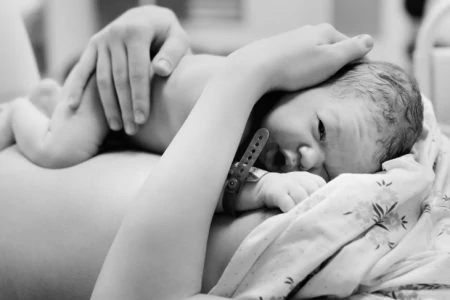Do you have questions about the lightening that happens toward the end of pregnancy?
Women frequently talk about the baby “dropping,” but if you’ve never experienced it yourself, it can seem a bit mysterious.
We’ve gathered all the info you need to know about baby dropping — from why it happens to what it feels like.
Key Takeaways
- “Baby dropping” refers to the baby’s head moving lower into the mother’s pelvis, settling into position for birth.
- This occurs toward the end of the third trimester and signals that the baby is ready for birth.
- After baby drops, the mother will likely find it easier to breathe and eat due to less compression on internal organs.
- Your doctor or midwife can check if the baby has dropped by performing a vaginal exam.
- The point in pregnancy when the baby drops varies, but typically occurs two to four weeks before labor starts for first-time mothers.
- What is Baby Dropping?
- What Happens When My Baby Drops?
- When Should I Expect My Baby to Drop?
- Can I Predict When My Baby Will Drop?
- How Quickly Does My Baby Drop During Pregnancy?
- What Does It Feel Like When My Baby Drops?
- What Types of Symptoms Can I Expect After My Baby Drops?
- Can I Tell The Position of My Baby After They’ve Dropped?
- What If My Baby Doesn’t Drop?
- How Can I Make My Baby Drop?
- FAQs
- The Bottom Line
What is Baby Dropping?
“Baby dropping” can seem like a shocking term if you’re not familiar with it. After all, everyone knows that it’s not good to drop a baby.
In the context of pregnancy, however, it’s a natural occurrence that comes toward the end of the third trimester and signals the baby is getting ready for birth. The “drop” refers to the baby’s head moving lower into your pelvis and settling into position to move through the birth canal.
When this happens, your baby will take up less space in your upper torso and put less compression on your internal organs like the lungs and stomach. For this reason, you will likely find it easier to breathe deeply and eat more comfortably after your baby drops.
Because of this sensation, baby dropping is also referred to as lightening.
What Happens When My Baby Drops?
In early pregnancy, babies have plenty of room to move around in the womb. They are twisting, turning, and flipping regularly.
As your baby grows, they begin to run out of space. You can still feel that they’re extremely active — kicking, stretching, and even rotating. However, as your baby gets bigger, they start to run out of room to move around, restricted by your rib cage, internal organs, and the uterus itself.
At some point near the end of your pregnancy, your baby will get into position for labor and stay put. Ideally, this will be with their head down, facing your back.
Once your baby is in an optimal position, they can begin to move down into the pelvis. The exact point where your baby is sitting is measured in stations (1).
- -3 station: The baby’s head is still above the pelvis.
- 0 station: The baby’s head is positioned in the pelvis.
- +3 station: The baby’s head is proceeding through the birth canal, and the baby is crowning.
Your OB provider can check whether your baby has dropped by performing a vaginal exam when they check your cervical dilation and effacement. These exams may be done at your prenatal visits during your final month of pregnancy or if you suspect you are in labor. If a vaginal examination makes you uncomfortable, you can always ask if the check is necessary and decline it.
If your doctor or midwife feels your baby sitting high in the pelvis, this means the baby is at -3 station or considered ballotable. For each approximate centimeter they descend into the pelvis, one number is added, measuring you at -2 or -1 station.
Where your baby lies in the pelvis is identified by bony prominences that your health care provider may feel called the ischial spines. If the head floats away from my fingers when I am checking a patient, it means the baby may not even be engaged in the pelvis yet, and they are considered ballotable. Ballotable means that when I push on the baby’s head, it floats up out of the pelvis and away from my fingers.
Editor's Note:
Caitlin Goodwin, MSN, RN, CNMWhen the baby is solidly positioned in the pelvis, they are considered to be fully engaged. This is the point at which you would say your baby has officially “dropped.”
Take Note
When Should I Expect My Baby to Drop?
The point in pregnancy when your baby drops varies drastically between mothers, but it tends to occur earlier for first-time mothers than mothers who have delivered a baby before.
If this is your first pregnancy, you can expect your baby will drop about two to four weeks before labor begins. However, lightening is not a reliable indicator labor is imminent, so don’t make too much of it if you feel your baby has dropped.
If you’ve delivered a baby before, you may not experience any noticeable lightening during your third trimester. It’s common for babies born to experienced mothers to wait to drop until active labor has begun.
Can I Predict When My Baby Will Drop?
Unfortunately, there are no predictors of when your baby will drop. However, contractions help move your baby down into your pelvis.
While Braxton Hicks contractions aren’t effective at progressing labor as they don’t cause your cervix to dilate, they do help to move your baby down into position. So if you feel Braxton Hicks contractions, know that they’re accomplishing more than just helping your uterus “warm up” for labor. They might be helping your baby get into place, too.
How Quickly Does My Baby Drop During Pregnancy?
The term “dropping” makes it sound like the lightening process is a quick, sudden, dramatic occurrence. And while it’s possible that it may happen within a few seconds, it’s also possible it will happen throughout several weeks.
For first-time moms who can expect their baby to drop a few weeks before delivery, they may discover at their weekly prenatal appointments that their baby has been descending the stations gradually. Women who have previously given birth may discover the baby remains high and then descends completely in one swift contraction during labor.
What Does It Feel Like When My Baby Drops?
You probably won’t experience any noticeable symptoms when your baby drops, especially if it is gradual. Lightening is something you tend to notice after the fact.
With both of my kids, dropping was sudden, immediate, and completely different.
With my first, I was experiencing Braxton Hicks contractions regularly, but with no associated pain — it simply presented as abdominal tightening. One night on a walk, I felt a particularly strong tightening and felt physically lighter immediately afterward. I didn’t deliver until weeks later, but I swear that’s the moment it happened.
With my second, my baby didn’t drop until the moment they were ready to be born. I was on my way to the hospital in labor when simultaneously my water broke, I felt a literal “thump” in my pelvis, and my body started pushing the baby out uncontrollably. Up until that point, my baby had been completely undescended.
Each mother’s experience varies widely, but we rarely talk about the process of lightening. Ask your friends about their experiences so you can start to collect ideas of what it may feel like when it happens to you.
What Types of Symptoms Can I Expect After My Baby Drops?
You might not be able to predict in advance when lightening will happen, but you will notice some changes after.
- Breathing may feel easier: This may be the most noticeable change. When you near the end of your pregnancy, it can be challenging to take a deep breath, and you may get more easily winded because the baby is putting pressure on your lungs. When your baby drops, they ease this pressure, allowing you to take a full, deep breath.
- You may have to pee more often: Just when you thought your bladder couldn’t possibly get much smaller, your baby drops and puts even more pressure on it. This can result in a more frequent need to urinate, along with a greater sense of urgency when the need arises. You may even find yourself leaking urine since there is so much added pressure on your bladder.
- You may be able to eat more: Though your cravings and appetite during pregnancy make you ravenous, you may have noticed your eyes are bigger than your stomach. Because your stomach is compressed, you can’t fit as much food in there as you may like, making you feel full a lot more quickly than you’d expect. Once your baby drops, you may notice your stomach has a larger capacity due to the decreased pressure on it.
- You may have less heartburn: If you suffer from heartburn while pregnant, you can look forward to this welcome relief. Since your stomach is less compressed once your baby drops, your stomach acids may no longer be squeezed up the esophagus, helping to decrease both the frequency and severity of your 0heartburn.
- Your belly may look visibly lower: This one you may not notice on your own — especially if your baby drops slowly. You may notice that instead of carrying high in your abdomen, your baby now appears much lower. You also may find your friends commenting, “It looks like you’ve dropped!” For this benchmark, it’s totally okay to rely on the opinion of family and friends. After all, since they don’t live with your belly 24/7, the change may be much more dramatic to them than it is to you, who would experience the dropping more slowly.
- You may start waddling: Your center of gravity shifts when you’re pregnant, and carrying around all that extra weight isn’t exactly comfortable. Your gait will naturally shift as your belly expands, but once the baby drops, the real fun can begin. Your baby’s lower position results in increased pelvic pressure, which can be uncomfortable and cause you to waddle (3).
- You may have more discharge: The further your baby moves into your pelvis, the more pressure it begins to put on your cervix. This could cause your mucus plug to loosen or just cause an overall increase in cervical discharge.
- You may experience increased contractions: Once your baby is in position, your body may ramp up its preparations for labor. You may notice an increase in Braxton Hicks contractions — or even real contractions that start and stop without ramping up into hard labor.
- You may have increased pelvic pain: After your baby has settled into your pelvis, you may notice increased sensations in that area. You may feel pain in the center of your pubic bone as it begins to open. This is called Symphysis Pubis Dysfunction. You may also experience sharp pain in your cervix as the baby’s head compresses the nerves, or you may just feel extra pressure low in your pelvis, like you’re carrying a bowling ball between your legs. Using a maternity support belt can potentially help you ease the pain.
Can I Tell The Position of My Baby After They’ve Dropped?
While it’s possible for your baby to move in and out of stations, once your baby becomes fully engaged, it’s likely they will stay put and continue progressing. This means you should be able to tell your baby’s position — and ideally, they will be in the proper position for labor.
The ideal labor position is head-down, facing your back — also known as anterior cephalic positioning. If your baby is facing your front, it’s called posterior cephalic positioning or “sunny-side up” (4). When you feel your belly, the two most easily identifiable body parts are the head and the buttocks — but unfortunately, they feel very similar.
You will primarily feel kicks beneath your ribs and hiccups below your belly button if your baby is positioned correctly. If your baby is posterior-facing, your belly may not appear quite as round and big, and you may feel more kicks on the front of your belly.
If your baby is breech, meaning they are descending into the pelvis feet-first, you will likely feel kicks lower in your abdomen or feel an uncomfortable and hard lump — your baby’s head — right beneath your ribs.
Let Your OB Worry For You
If you have any questions about your baby’s positioning, don’t hesitate to ask, as it may affect your birth plan.
What If My Baby Doesn’t Drop?
If your baby doesn’t drop before labor, don’t worry. Many babies don’t move down until you’re actively in labor.
However, sometimes a failure to descend could mean your baby isn’t in proper birthing position yet. And if labor begins when your baby isn’t in position, it could mean your early labor may be lengthy and arduous as your body tries to move your baby into the proper position (5).
How Can I Make My Baby Drop?
If you’re approaching the end of your pregnancy and your baby has yet to engage in your pelvis, you may consider taking steps to speed up the process.
But before you do anything to try and make your baby drop, make sure your doctor has confirmed your baby is in a head-down, posterior position. Otherwise, your efforts may be useless. And never try to help your baby drop prior to 37 weeks, as the process of dropping may put extra pressure on your cervix and stimulate labor.
Here are some things to try:
- Walk: The process of walking helps rock your baby back and forth gently, and the force of gravity can help your baby descend further into the pelvis. As simple as it sounds, walking is one of the best things you can do during pregnancy — for health, stimulating labor, and helping your baby drop.
- Squats: Squats not only help open your pelvis, but they also help push your baby further down. Doing these late in pregnancy, it’s best to hold onto a chair or table to maintain balance as your center of gravity may be a little off.
- Pelvic opening exercises: Sit on the couch and open your legs wide. Lean forward — not down — as you force the weight from your belly down into your pelvis. Never try to stretch yourself beyond your range of motion or push hard on your stomach, but just stretch gently as you try to ease your baby downward.
- Hands and knees: Get down on all fours. The gentle curve of your belly acts as a hammock to help your baby’s back get into an ideal position. Once your baby is in a better position, they may descend into your pelvis easily.
- Chiropractic care: A chiropractor may perform an adjustment to align your spine better. This will provide more room in your pelvis to help your baby drop.
FAQs
The Bottom Line
Toward the end of your pregnancy, your baby will drop down into your pelvis to position themselves for birth. This is also known as lightening or becoming fully engaged.
It frequently occurs a few weeks before labor for first-time moms and much later for experienced moms. For many women who have had children before, it may not even occur until they are in active labor.
It’s exciting when your baby drops as it signals things are moving along in your pregnancy, but it doesn’t necessarily mean that labor is imminent. However, it’s worth celebrating because it means your baby is that much closer to landing in your arms.










